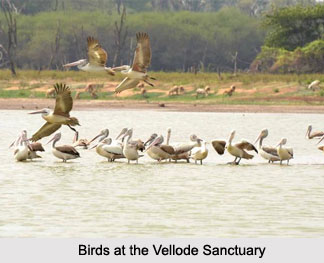 Vellode Birds Sanctuary is located in Erode District of Tamil Nadu. It is spread over an area of 200 acres. The Sanctuary is situated in Vadamugam Vellode village and is 12 km from Erode, along Chennimalai main road. March to June are the hottest months. The average maximum temperature is about 30 degree Centigrade and the average minimum temperature is about 19 degree Centigrade. During the peak summer the maximum temperature often reaches 38 degree Centigrade. This area receives rainfall mainly from the Northeast monsoon between September to December, whereas the period between February to June generally remains dry. The sanctuary comes under the List of Protected areas of Tamil Nadu. The reserve lies in the city outskirts at a distance of 12 km.
Vellode Birds Sanctuary is located in Erode District of Tamil Nadu. It is spread over an area of 200 acres. The Sanctuary is situated in Vadamugam Vellode village and is 12 km from Erode, along Chennimalai main road. March to June are the hottest months. The average maximum temperature is about 30 degree Centigrade and the average minimum temperature is about 19 degree Centigrade. During the peak summer the maximum temperature often reaches 38 degree Centigrade. This area receives rainfall mainly from the Northeast monsoon between September to December, whereas the period between February to June generally remains dry. The sanctuary comes under the List of Protected areas of Tamil Nadu. The reserve lies in the city outskirts at a distance of 12 km.
Flora and Fauna of Vellode Bird Sanctuary
Vellode Bird Sanctuary is rich is flora and fauna. The Vellode Birds Sanctuary is a storage tank and as such there are no forests in this tank. The main vegetation of the sanctuary consists of Acacia nilotica plantation. The other tree species present in the sanctuary includes Azadirachta indica, Palmyra and eucalyptus plantation all along the bund and profuse growth of Prosopis juliflora.
The sanctuary provides a habitat to innumerable resident and migratory bird species. The migratory birds start arriving in the sanctuary at the onset of the Northeast monsoon. The Sanctuary happens to be an ideal habitat for the birds, because of the availability of abundant feed in the tank and in the neighbouring agricultural fields. It also provides plenty of trees for perching and nesting. Some easily found bird species include cormorants, teals, pintail ducks, and darters. There are abundant fishes and other aquatic organisms present in the tank. These also form a part of food for many resident birds.
A watch tower has been constructed for the benefit of the tourists. From here they can get a glance of the entire sanctuary. An interpretation centre has also been constructed for creating awareness among the visitors especially to the student visiting the sanctuary. The best time to visit the sanctuary is from November to April.
Vellode Bird Sanctuary is well connected with all modes of transport. The sanctuary is situated 12 km away from Erode toward Chennimalai main road and is easily accessible by road Erode is 12 km and Chennimalai is 14 km. there is a diversion road towards North on Erode Chennimalai road from Mettupalayam which takes one to this sanctuary.











